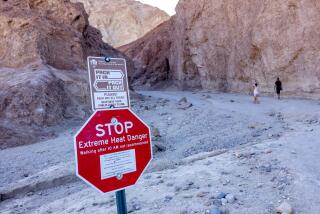How hot was it? 2014 was Earth’s warmest year on record, data show
- Share via
The average surface temperature on Earth was higher in 2014 than at any time since scientists began taking detailed measurements 135 years ago.
The 1.4-degree Fahrenheit rise since 1880 confirms long-term warming patterns and renewed alarm about changes that could flood coasts, provoke more severe storms and dry out croplands around the globe, climate experts at NASA and the National Oceanic and Atmospheric Administration said Friday.
Scientists at the two agencies relied on data collected by 6,300 land-based weather stations around the world, from research stations in Antarctica and from a network of ships and satellite-communicating buoys that dot the oceans. Experts at NOAA determined that Earth’s average surface temperature in 2014 was 1.24 degrees above the 20th century average of 57 degrees Fahrenheit. A related analysis from NASA scientists also confirmed a record increase above a base line period between 1951 and 1980.
In a particularly ominous sign, 2014 marked the first time in 25 years that a global surface temperature record was set without a strong warming influence from the Pacific Ocean current oscillation known as El Niño.
December “sealed the deal” by setting a new record as the warmest month ever measured, NOAA reported. May, June, August and September set new records for monthly highs, and October tied a previous high, NOAA said.
The data add to a recent string of record warmth planet-wide. Nine of the 10 warmest years on record have occurred since 2002, according to NOAA. (The other top 10 year was 1998, which ranks fourth in the record books due in part to a particularly strong El Niño phase.)
The warming trend can be explained only by including the effects of human activity, including the burning of fossil fuels that add heat-trapping greenhouse gases to Earth’s atmosphere, agency scientists said.
“Greenhouse gas trends are responsible for the majority of the trend that we see,” said Gavin Schmidt, director of NASA’s Goddard Institute for Space Studies in New York. Because such emissions continue to rise, Schmidt added, “we may anticipate further record highs in the years to come.”
Although land surface temperature ranked fourth in the record books, record temperatures in every ocean basin drove the global average to new heights. Ocean water retains heat longer, and heat-driven expansion contributes to sea level rise.
“This was very clearly the warmest year in the ocean records,” Schmidt said. “It wasn’t quite the warmest year in the land records, but combined, this did actually give the warmest year” since scientists began tracking global surface temperatures in 1880.
The warming also came despite a decidedly colder U.S. winter driven by a “polar vortex,” according to the agencies. That cold anomaly was overwhelmed by many other abnormally hot periods elsewhere throughout the year, including searing heat that worsened the ongoing drought in the Western U.S. and wilting heat spells in Europe and Australia.
Areas of unusual warmth also included Russia’s vast Siberia region and Alaska — temperatures in Anchorage did not dip below zero degrees last year, another first.
Temperatures in far northern latitudes are rising at twice the rate seen in more temperate zones, melting snow cover, and that could hamper Earth’s ability to reflect heat, climate scientists said.
“We see significant decreases in spring and early summer months,” said Tom Karl, head of NASA’s National Climatic Data Center in North Carolina. “It’s important because that’s when the sun is high. A lot of additional heat is gained because there’s less snow to reflect the sunlight back to space.”
Higher summer temperatures likewise take a toll on Arctic sea ice, which fell to the sixth lowest level last year, Schmidt noted.
Meanwhile, Antarctic sea ice extent hit record highs in 2014, “which is a little surprising given the warmth on the rest of the planet,” he said.
Antarctic sea ice extent is not as closely linked to surface temperature trends, and is influenced by many local factors, including winds tied to the hole in the ozone layer and additional fresh water from melting land ice sheets, Schmidt said.
Skeptics often point to record-setting temperatures in 1998 to argue that global warming has abated. But agency officials said the new data show the long-term trend has been a steady rise since the 1970s.
“2014 is exactly where we would’ve expected, before 1998,” said Schmidt. “There are going to be periods when short-term trends go up and go down — that’s just the nature of the beast. But there’s no evidence that the long-term trend is much different from what it has been.”
Tim Barnett, a marine physicist with the Scripps Institution of Oceanography at UC San Diego, said it was time to lay to rest any speculation of a warming “hiatus” since the late 1990s.
“You have to interpret what you’re seeing over the long haul,” he said. “You have to look at a couple of decades at least before you begin to see that things have changed.”
Until last year, the warmest years since the 1998 high were 2005 and 2010. The global average for 2014 edged those years by 0.07 of a degree Fahrenheit, government scientists said.
Overall, the global annual temperature increased at an average rate of 0.11 of a degree Fahrenheit per decade between 1880 and 1970. Since then, it has increased by 0.28 of a degree per decade, NOAA data show.
In the U.S., all-time record highs were set in California, Alaska, Nevada and New Mexico, even as most of the Midwest and East Coast experienced temperatures far lower than normal, NOAA said. The annual average for the 48 contiguous states was a half-degree above the area’s 20th century average of 52.6 degrees — barely enough to break into the top 35 warmest years.
@LATsciguy







